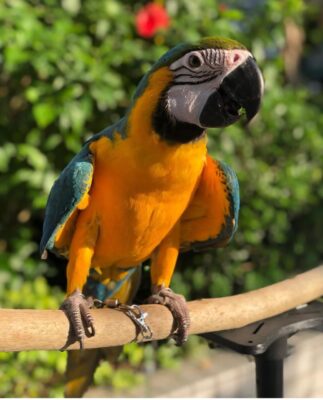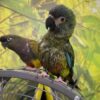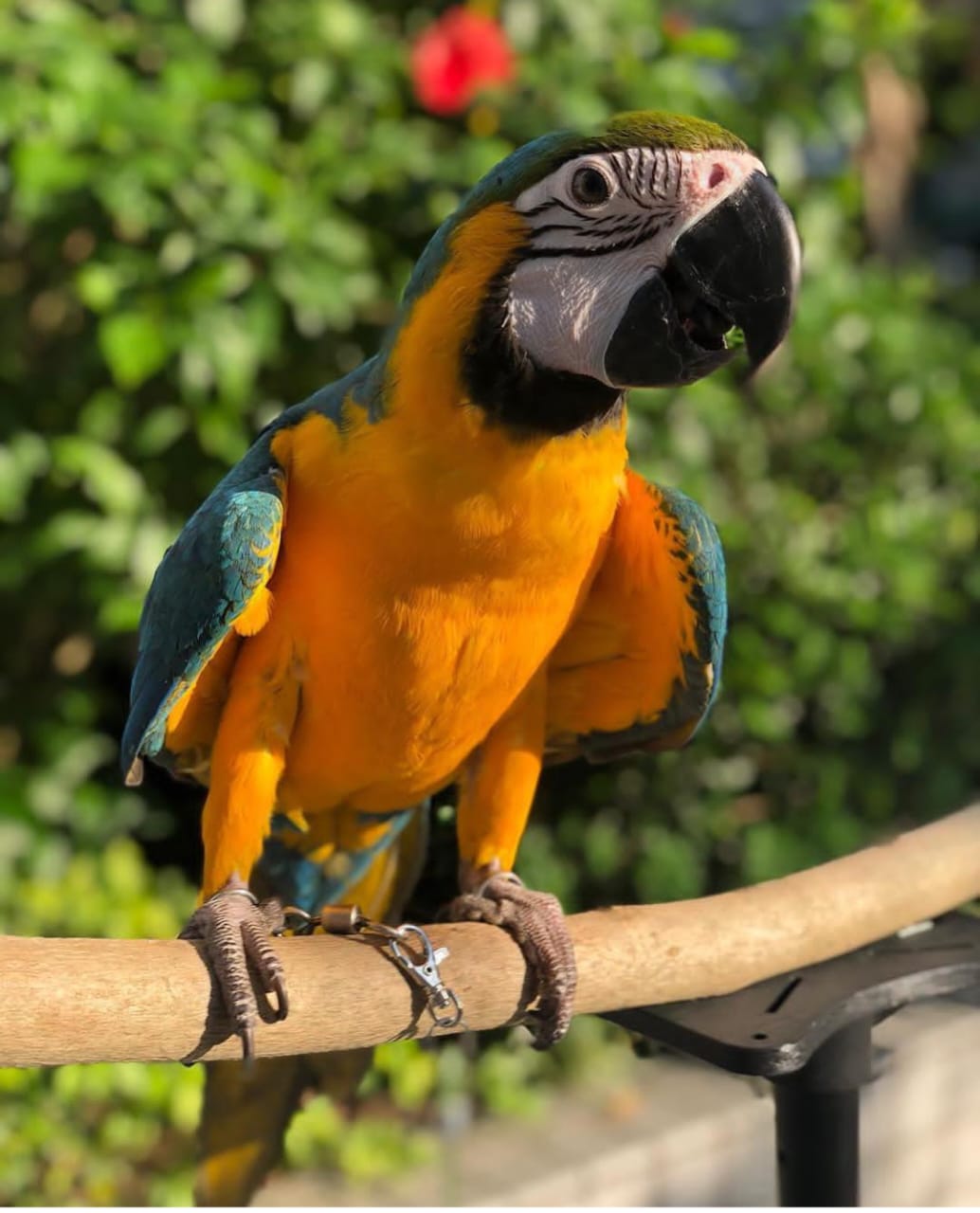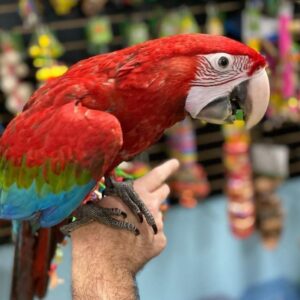Exploring Blue and Yellow Macaws for Sale
Blue and yellow macaws for sale, also known as blue and gold macaws, are magnificent parrots renowned for their stunning plumage and playful personalities. If you’re considering welcoming one of these beautiful birds into your home, this guide will provide you with everything you need to know about finding, caring for, and enjoying the company of a blue and yellow macaw.
Understanding Blue and Yellow Macaws for sale:
What Makes Blue and Yellow Macaws for Sale Unique?

Blue and yellow macaws, scientifically known as Ara ararauna, are among the most recognizable and beloved parrot species. Here are some key features that make them stand out:
- Vibrant Plumage: Blue and yellow macaws for sale boast a striking combination of bright blue feathers on their upperparts and vibrant golden-yellow plumage on their underparts. This eye-catching coloration makes them a favorite among bird enthusiasts.
- Social Nature: Blue and yellow macaws for sale are highly social birds that thrive on interaction and companionship. They form strong bonds with their human caregivers and enjoy being part of the family.
- Intelligent and Playful: These macaws are intelligent creatures with a playful demeanor. They love to engage in activities such as playing with toys, solving puzzles, and learning new tricks.
Finding Blue and Yellow Macaws for Sale:
Where to Look for Blue and Yellow Macaws:
When searching for blue and yellow macaws for sale, it’s essential to find a reputable source to ensure the health and well-being of your future pet. Here are some places to consider:
Avian Breeders: Working with a reputable breeder specializing in macaws is often the best way to find a healthy and well-socialized blue and yellow macaw. Look for breeders with a good reputation, who prioritize the welfare of their birds and provide proper care and socialization.
Pet Stores: Some pet stores may have blue and yellow macaws available for purchase. However, it’s crucial to research the store’s reputation and inquire about the bird’s background and health history.
Rescue Organizations: Adopting a blue and yellow macaw from a rescue organization is a compassionate choice that gives a second chance to birds in need. These organizations often have macaws available for adoption, and you’ll have the satisfaction of providing a loving home to a bird in need.
Online Platforms: Avian Nest Sanctuary and online marketplaces may also have listings for blue and yellow macaws for sale. Exercise caution and thoroughly research any sellers to ensure they are reputable and ethical.
Considerations When Choosing Blue and Yellow Macaws for sale:
Health and Temperament: When choosing a blue and yellow macaw, prioritize health and temperament. Look for birds that are alert, active, and exhibit bright eyes and glossy feathers. Avoid birds that show signs of illness or distress, such as lethargy, fluffed feathers, or nasal discharge.
Additionally, spend time interacting with the bird to assess its temperament and compatibility with your lifestyle. Blue and yellow macaws are known for their outgoing and affectionate nature, so choose a bird that enjoys human interaction and shows a willingness to bond with you.
Housing and Enclosure: Providing a spacious and enriching environment is essential for the health and well-being of your blue and yellow macaw. Choose a large cage or aviary that allows ample room for movement and includes perches of varying sizes and textures.
Place the cage in a well-lit area with plenty of natural sunlight, but avoid direct drafts or extreme temperatures. Provide toys, puzzles, and enrichment activities to keep your macaw mentally stimulated and prevent boredom.
Diet and Nutrition: A balanced diet is crucial for the health and longevity of your blue and yellow macaw. Offer a variety of fresh fruits, vegetables, nuts, and seeds to provide essential nutrients and vitamins. Avoid feeding high-fat or sugary foods, as these can lead to obesity and health problems.
Supplement your macaw’s diet with a high-quality pelleted food formulated specifically for parrots. Ensure access to clean, fresh water at all times, and monitor your bird’s eating habits to detect any changes or potential health issues.
Veterinary Care: Regular veterinary check-ups are essential for maintaining your blue and yellow macaw. Find a veterinarian experienced in avian medicine and schedule annual wellness exams for your bird.
Be proactive about preventive care, including vaccinations, parasite control, and routine blood tests. Discuss any concerns or changes in your macaw’s behavior or health with your veterinarian promptly.
Conclusion: Welcoming a blue and yellow macaw into your life can be a rewarding experience. By finding a reputable source, choosing the right bird for your lifestyle, and providing proper care and attention, you’ll enjoy years of companionship and joy with your colorful feathered friend. With dedication and love, your pet macaw will flourish as a cherished member of your family.
FAQ’s
How much does a blue-and-yellow macaw cost?
The cost of a blue-and-yellow macaw varies depending on factors like age, breeder reputation, and location, typically ranging from $1,500 to $3,500. However, prices can be higher for hand-raised or trained birds. Adopting a rescue organization may offer a more affordable option.
What is the most expensive macaw in the world?
The hyacinth macaw is widely considered the most expensive macaw species globally. Renowned for its striking cobalt-blue plumage and impressive size, prices for these majestic birds can range from $8,000 to $15,000 or more. The hyacinth macaw’s rarity, coupled with its specialized care requirements and limited breeding success, contributes to its high price tag. Despite the cost, enthusiasts are drawn to the hyacinth macaw’s beauty and intelligence, making it a highly sought-after addition to aviaries and collections for those willing to invest in its care.
How many eggs do blue-and-yellow macaws lay?
Blue-and-yellow macaws typically lay 2 to 4 eggs per clutch, with the average being around 3 eggs. These large, white eggs are incubated for approximately 24 to 28 days before hatching. Both parents share the responsibility of incubating the eggs and caring for the chicks once they hatch. Blue-and-yellow macaws are known for their strong pair bonds and cooperative breeding behavior, ensuring the successful rearing of their offspring. This reproductive strategy helps maintain stable populations of blue-and-yellow macaws in their natural habitat and contributes to their continued survival as a species.
Where can I find blue-and-yellow macaws?








Reviews
There are no reviews yet.